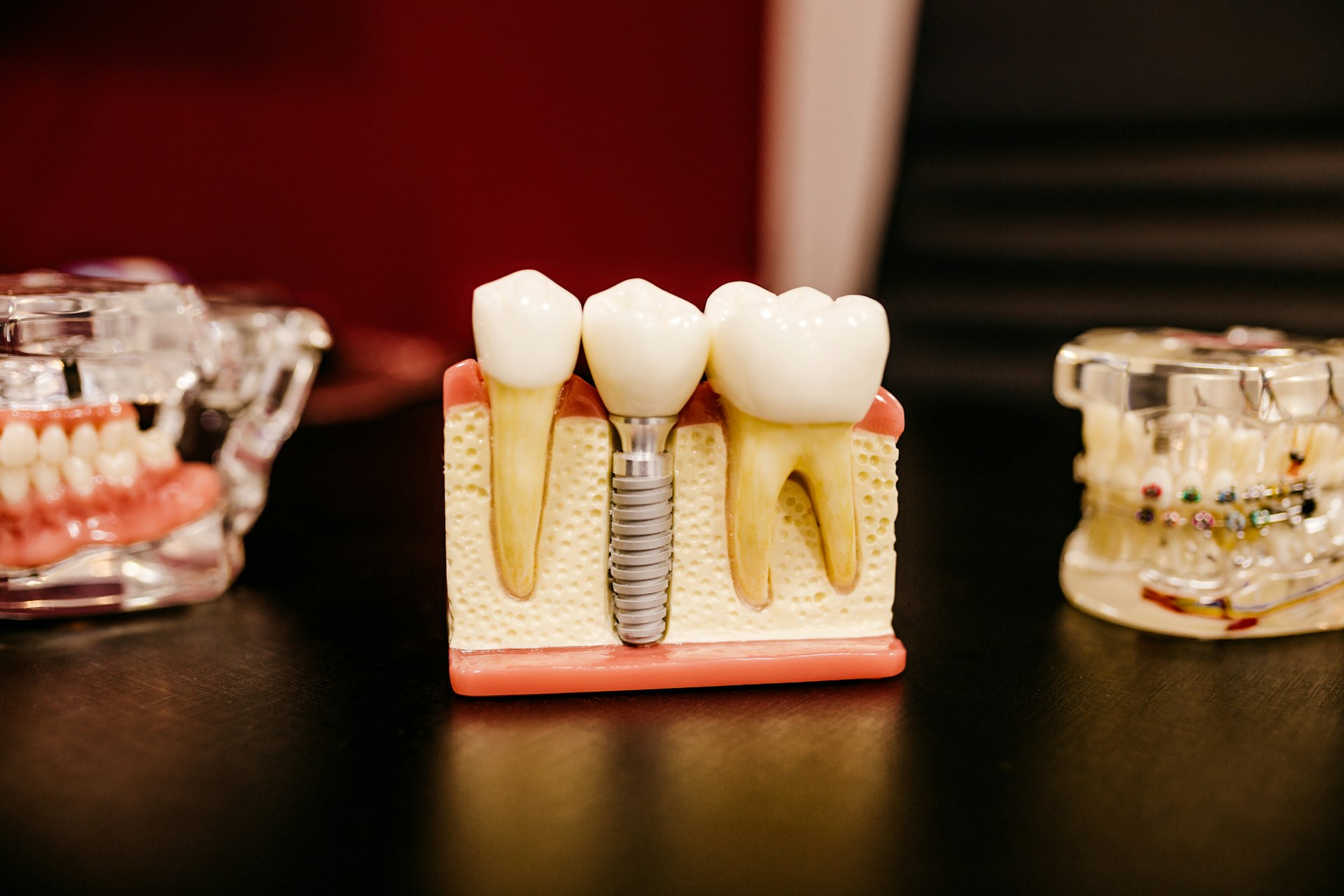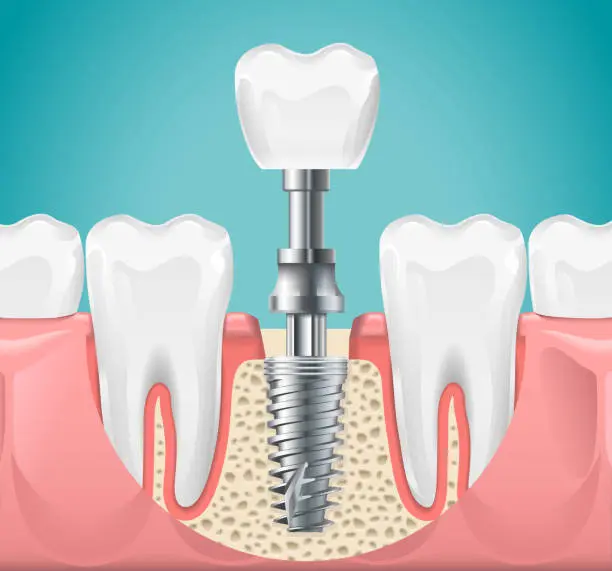Implants
Dental implants are artificial tooth roots made of biocompatible materials such as titanium. They are surgically placed into the jawbone beneath the gums to provide a stable foundation for replacement teeth.
Types
Endosteal implants are the most commonly used type of dental implant. They are typically made from titanium and shaped like small screws. They are placed directly into the jawbone to act as an artificial root to hold a replacement tooth or bridge. They offer a reliable and highly effective solution for replacing missing teeth, with outcomes that closely mimic natural teeth both in appearance and function.
Subperiosteal implants consist of a metal frame that is fabricated to fit over the jawbone. The frame has posts attached to it that protrude through the gums. These posts provide the stable base onto which crowns, bridges, or dentures can be attached. They can be a viable alternative for certain patients, offering a way to restore one's smile even with significant jawbone loss where other implant methods are not suitable. However, selecting the right type of implant depends on a detailed examination and consultation with a dental professional skilled in implantology.
Gallery
Visual insights to help you understand what to expect from your treatment. For more content, please refer to our Education Hub.

Benefits & Considerations
Everything you need to know to make an informed decision about your treatment.
Benefits
Improved Appearance
Dental implants are designed to look, feel, and function like natural teeth. They are also designed to fuse with bone, becoming permanent.
Bone and Facial Features Preservation
Implants preserve natural tooth tissue by avoiding the need to cut down adjacent teeth for bridgework. Implants preserve bone and largely reduce bone resorption (which causes loss of jawbone height). They help restore your jawbone structure because they reduce the load on the remaining oral structures/teeth and preserve natural tooth tissue.
Functionality
Unlike dentures that can slip within the mouth and cause mumbling or slurring of words, dental implants allow you to speak without the worry that teeth might slip. Sliding dentures can also make chewing difficult. Dental implants function like your own teeth, allowing you to eat your favorite foods with confidence and without pain.
Improved Oral Health
Unlike a tooth-supported bridge, dental implants don’t require reducing other teeth. More of your own teeth are left intact, improving long-term oral health. Individual implants also allow easier access between teeth, improving oral hygiene.
Convenience
Dental implants eliminate the embarrassing inconvenience of removing dentures, as well as the need for messy adhesives to keep them in place.
Durability
With proper care, dental implants can last a lifetime, providing a long-term solution for tooth replacement.
Considerations
Surgical Risks
Like any surgical procedure, implant placement carries risks such as infection, bleeding, and potential damage to nearby structures. Our skilled team implements strict sterilisation measures and advanced techniques to reduce these risks, ensuring your safety and comfort throughout the process.
Osseointegration
Implant failure can occur if it does not properly fuse with the jawbone, often due to factors like infection, low bone density, or excessive pressure. Our dental team assesses each patient's oral health and bone density to optimise outcomes. We also offer bone grafting to enhance bone availability for successful implant placement, increasing the likelihood of osseointegration.
Peri-implantitis Control
This condition involves inflammation of the tissues surrounding dental implants, both soft and hard. It resembles gum disease and can lead to bone loss around the implant, ultimately causing its failure. Our clinic prioritises preventive measures and utilizes advanced implant materials designed to enhance bone regeneration and minimise infection, ensuring the longevity and health of your implants.
Implant Placement
For upper jaw implants, our experts utilize 3D cone beam CT scans for precise placement, reducing sinus complication risks. In the lower jaw, we carefully avoid the mandibular nerve using guided surgery techniques to ensure safety during the procedure.
Treatment Procedure
Let's walk through your treatment procedure from start to finish.
Initial Consultation
The dentist will perform a thorough exam, which may include X-rays and 3D imaging, and review your medical history to ensure you are a suitable candidate.
Treatment Planning
Depending on the condition of your dental health, your dentist may involve other specialists, such as a periodontist or an oral surgeon. The plan will consider factors like the location of missing teeth and the health of your jawbone.
Within our practice, our skilled dental technician team is able to plan the implant placement with our specialised implant planning software for form, function, and aesthetics, whilst addressing all above considerations. A surgical guide is created in house to ensure the placement of the implant is correct with negligible error.
Implant Placement Surgery
On the day of the surgery, our skilled dentist begins by extracting any remaining teeth that need to be removed. Next, the dental implants are carefully placed into the jawbone, guided by a surgical guide created using advanced planning software. The gums are then sutured to allow for proper healing.
If the jawbone is not dense enough to support the implants, bone grafting might be needed. This procedure involves taking bone from another area of your body or using a synthetic material to augment the jawbone. Bone grafts require several months to heal.
Customised Healing Abutment
Within our practice, our technician team is able to design and manufacture a customised healing abutment, which is screwed onto the implant. This abutment aids in the shaping of the soft tissue (gums) around the future tooth for optimal aesthetics. Additionally, this abutment minimises the risk of bacteria entering the implant socket, thus minimising the risk of peri-implantitis.
Osseointegration
Complete healing and integration of the implant with the jawbone can take anywhere from a few weeks to several months. During this time, you may have temporary crowns installed to allow you to eat and speak normally without stressing the implant site. These restorations are also designed and manufactured in-house for optimal form and function.
Abutment Placement
Once integration is complete, the customised healing abutment is removed and a second minor surgery might be required to place the final abutment — the piece where the crown will eventually attach. This procedure is typically less invasive and can often be performed under local anesthesia. The gums are reopened to expose the implant, the abutment is attached, and the gum tissue is then closed around, but not over, the abutment.
Permanent Crown - Design, Fabrication & Placement
After your gums heal, more impressions of your mouth and remaining teeth are taken to design the final crown - your final tooth. The crown is designed to mimic a functional tooth for optimal jaw movements whilst chewing, speaking, etc. The restorations are then manufactured in-house via state-of-the-art 3D printing or milling machinery. MODJAW technology may be utilised to ensure comfort and safety in performing dynamic jaw movements such as protrusion, lateral excursions, chewing, and speech.
After manufacturing, the crown is finished via polishing, staining and glazing to ensure an aesthetic visual appearance, and screwed in place by the dentist.
Post-Operative Care
Simple steps to protect your smile and ensure optimal results in the days following your procedure.
Oral Hygiene
Maintain good oral hygiene by brushing and flossing regularly to prevent plaque buildup and gum disease.
Regular Dental Visits
Schedule routine check-ups with your dentist to ensure the health and longevity of your dental implants.
Avoid Harmful Habits
Refrain from smoking and excessive alcohol consumption, as they can negatively impact implant healing and success rates.
Protective Mouthguard
If you engage in contact sports or teeth-grinding habits, wear a mouthguard to protect your implants from damage.

Dental implants offer a reliable and aesthetically pleasing solution for tooth replacement, restoring both function and confidence to individuals with missing teeth. While they require careful consideration and maintenance, the long-term benefits of dental implants make them a popular choice for many patients seeking a permanent dental solution. Consult with your dentist to determine if dental implants are the right option for you.